Bachelor of Early Childhood Education and Care
VerifiedAdded on 2023/06/07
|11
|2700
|305
AI Summary
This article explores the social, emotional and psychological aspects of children up to 5 years of age. It discusses the cognitive development theories by Piaget, Vygotsky and Bruner. The article emphasizes the importance of creating a safe and supportive environment for the development and wellbeing of children.
Contribute Materials
Your contribution can guide someone’s learning journey. Share your
documents today.
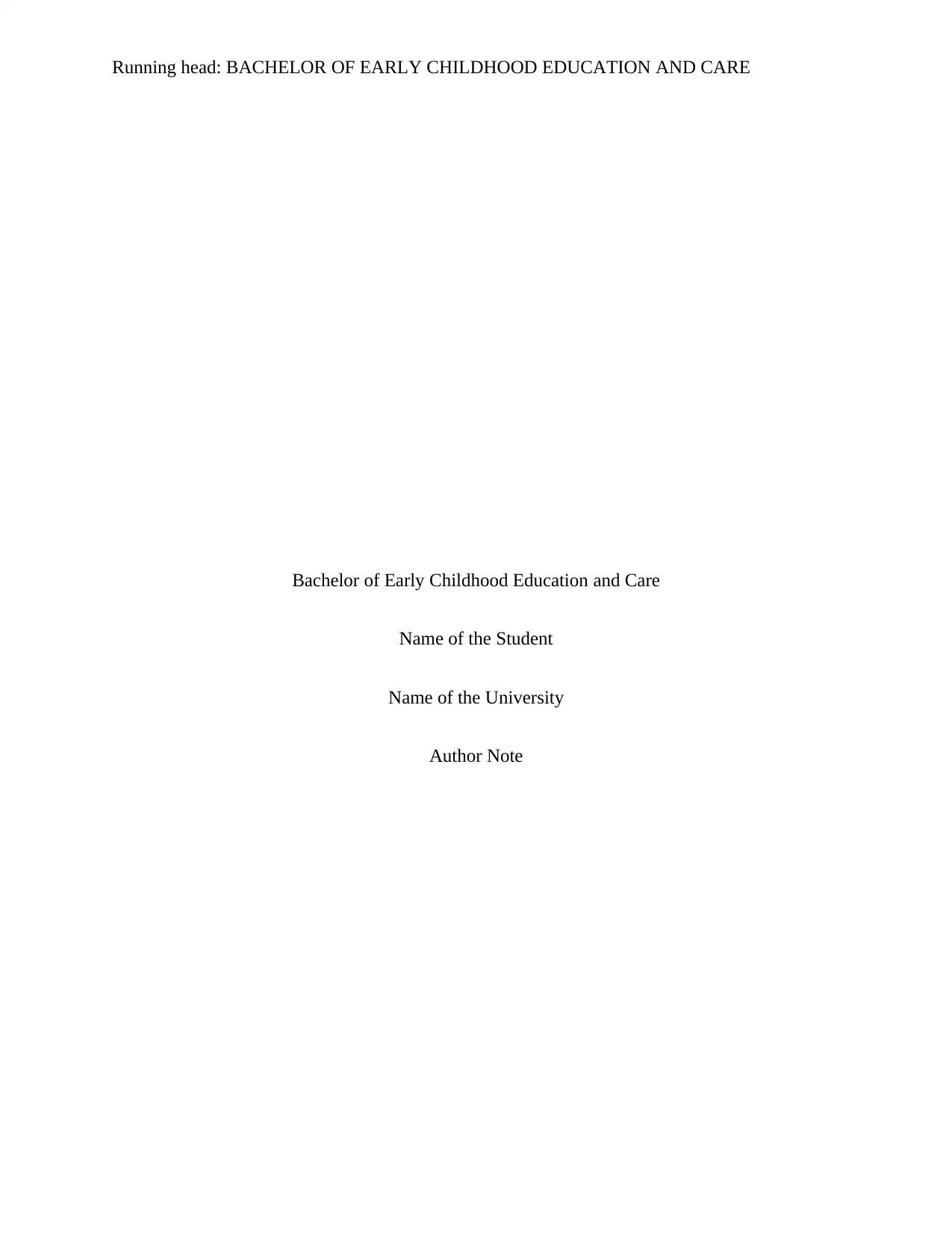
Running head: BACHELOR OF EARLY CHILDHOOD EDUCATION AND CARE
Bachelor of Early Childhood Education and Care
Name of the Student
Name of the University
Author Note
Bachelor of Early Childhood Education and Care
Name of the Student
Name of the University
Author Note
Secure Best Marks with AI Grader
Need help grading? Try our AI Grader for instant feedback on your assignments.
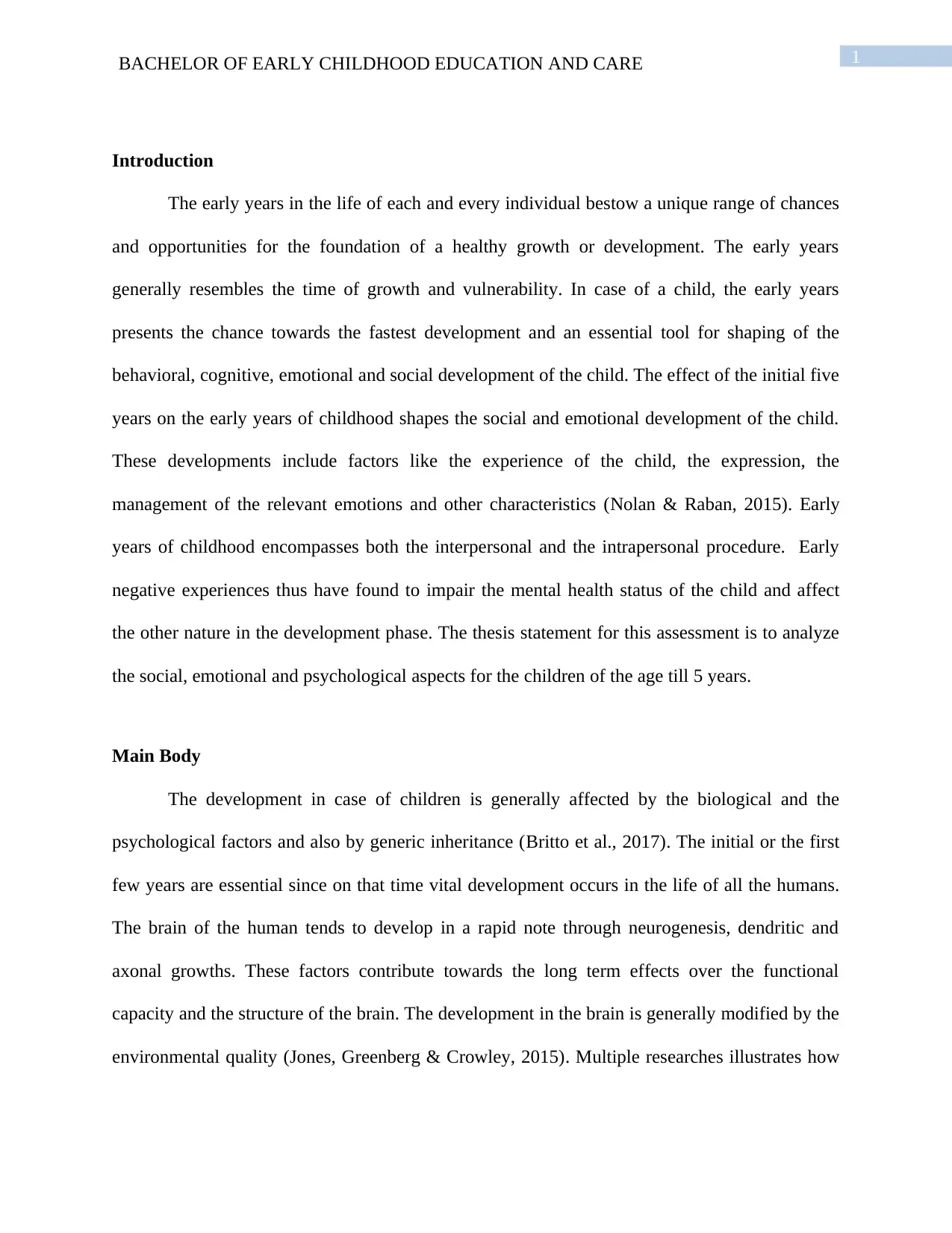
1BACHELOR OF EARLY CHILDHOOD EDUCATION AND CARE
Introduction
The early years in the life of each and every individual bestow a unique range of chances
and opportunities for the foundation of a healthy growth or development. The early years
generally resembles the time of growth and vulnerability. In case of a child, the early years
presents the chance towards the fastest development and an essential tool for shaping of the
behavioral, cognitive, emotional and social development of the child. The effect of the initial five
years on the early years of childhood shapes the social and emotional development of the child.
These developments include factors like the experience of the child, the expression, the
management of the relevant emotions and other characteristics (Nolan & Raban, 2015). Early
years of childhood encompasses both the interpersonal and the intrapersonal procedure. Early
negative experiences thus have found to impair the mental health status of the child and affect
the other nature in the development phase. The thesis statement for this assessment is to analyze
the social, emotional and psychological aspects for the children of the age till 5 years.
Main Body
The development in case of children is generally affected by the biological and the
psychological factors and also by generic inheritance (Britto et al., 2017). The initial or the first
few years are essential since on that time vital development occurs in the life of all the humans.
The brain of the human tends to develop in a rapid note through neurogenesis, dendritic and
axonal growths. These factors contribute towards the long term effects over the functional
capacity and the structure of the brain. The development in the brain is generally modified by the
environmental quality (Jones, Greenberg & Crowley, 2015). Multiple researches illustrates how
Introduction
The early years in the life of each and every individual bestow a unique range of chances
and opportunities for the foundation of a healthy growth or development. The early years
generally resembles the time of growth and vulnerability. In case of a child, the early years
presents the chance towards the fastest development and an essential tool for shaping of the
behavioral, cognitive, emotional and social development of the child. The effect of the initial five
years on the early years of childhood shapes the social and emotional development of the child.
These developments include factors like the experience of the child, the expression, the
management of the relevant emotions and other characteristics (Nolan & Raban, 2015). Early
years of childhood encompasses both the interpersonal and the intrapersonal procedure. Early
negative experiences thus have found to impair the mental health status of the child and affect
the other nature in the development phase. The thesis statement for this assessment is to analyze
the social, emotional and psychological aspects for the children of the age till 5 years.
Main Body
The development in case of children is generally affected by the biological and the
psychological factors and also by generic inheritance (Britto et al., 2017). The initial or the first
few years are essential since on that time vital development occurs in the life of all the humans.
The brain of the human tends to develop in a rapid note through neurogenesis, dendritic and
axonal growths. These factors contribute towards the long term effects over the functional
capacity and the structure of the brain. The development in the brain is generally modified by the
environmental quality (Jones, Greenberg & Crowley, 2015). Multiple researches illustrates how
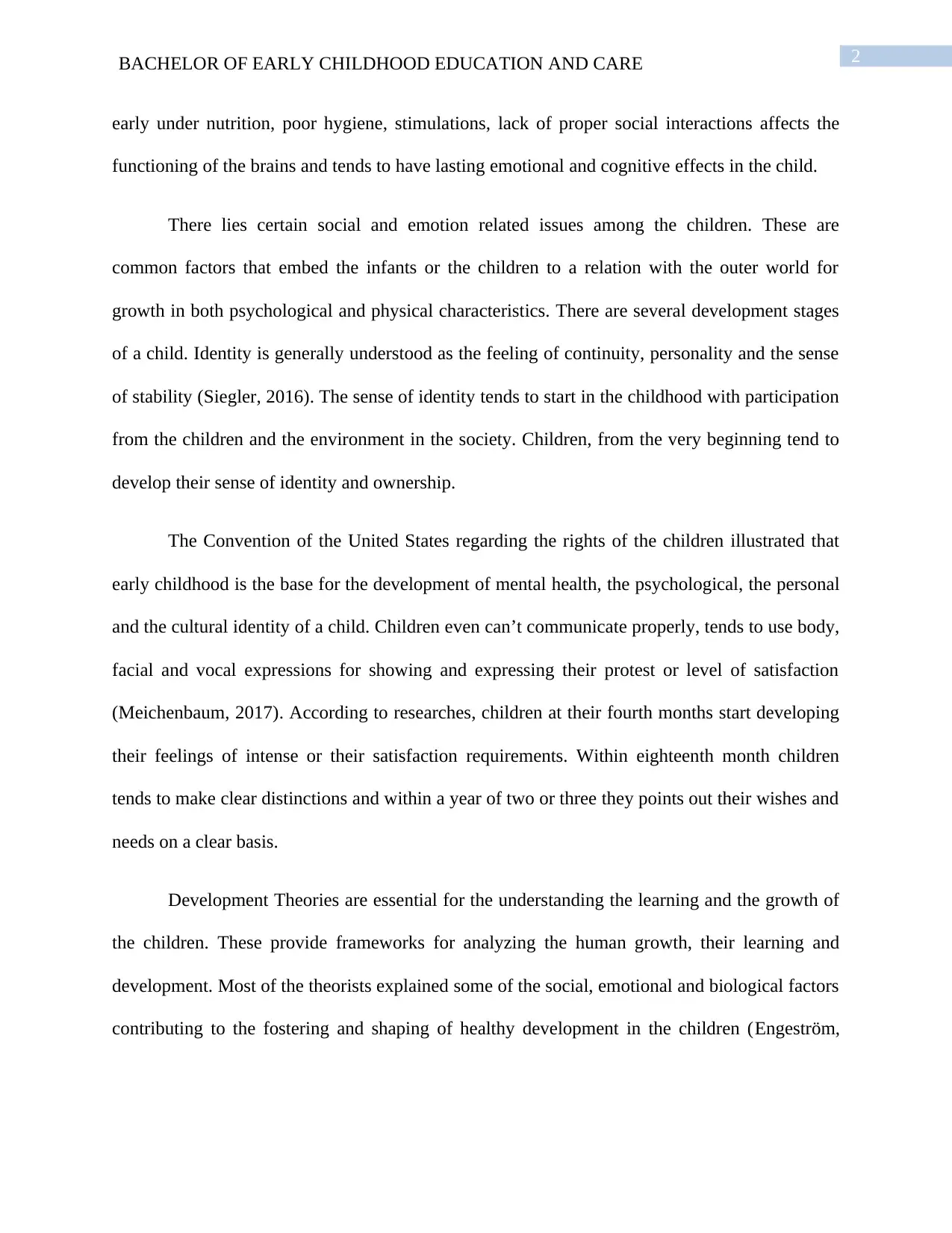
2BACHELOR OF EARLY CHILDHOOD EDUCATION AND CARE
early under nutrition, poor hygiene, stimulations, lack of proper social interactions affects the
functioning of the brains and tends to have lasting emotional and cognitive effects in the child.
There lies certain social and emotion related issues among the children. These are
common factors that embed the infants or the children to a relation with the outer world for
growth in both psychological and physical characteristics. There are several development stages
of a child. Identity is generally understood as the feeling of continuity, personality and the sense
of stability (Siegler, 2016). The sense of identity tends to start in the childhood with participation
from the children and the environment in the society. Children, from the very beginning tend to
develop their sense of identity and ownership.
The Convention of the United States regarding the rights of the children illustrated that
early childhood is the base for the development of mental health, the psychological, the personal
and the cultural identity of a child. Children even can’t communicate properly, tends to use body,
facial and vocal expressions for showing and expressing their protest or level of satisfaction
(Meichenbaum, 2017). According to researches, children at their fourth months start developing
their feelings of intense or their satisfaction requirements. Within eighteenth month children
tends to make clear distinctions and within a year of two or three they points out their wishes and
needs on a clear basis.
Development Theories are essential for the understanding the learning and the growth of
the children. These provide frameworks for analyzing the human growth, their learning and
development. Most of the theorists explained some of the social, emotional and biological factors
contributing to the fostering and shaping of healthy development in the children (Engeström,
early under nutrition, poor hygiene, stimulations, lack of proper social interactions affects the
functioning of the brains and tends to have lasting emotional and cognitive effects in the child.
There lies certain social and emotion related issues among the children. These are
common factors that embed the infants or the children to a relation with the outer world for
growth in both psychological and physical characteristics. There are several development stages
of a child. Identity is generally understood as the feeling of continuity, personality and the sense
of stability (Siegler, 2016). The sense of identity tends to start in the childhood with participation
from the children and the environment in the society. Children, from the very beginning tend to
develop their sense of identity and ownership.
The Convention of the United States regarding the rights of the children illustrated that
early childhood is the base for the development of mental health, the psychological, the personal
and the cultural identity of a child. Children even can’t communicate properly, tends to use body,
facial and vocal expressions for showing and expressing their protest or level of satisfaction
(Meichenbaum, 2017). According to researches, children at their fourth months start developing
their feelings of intense or their satisfaction requirements. Within eighteenth month children
tends to make clear distinctions and within a year of two or three they points out their wishes and
needs on a clear basis.
Development Theories are essential for the understanding the learning and the growth of
the children. These provide frameworks for analyzing the human growth, their learning and
development. Most of the theorists explained some of the social, emotional and biological factors
contributing to the fostering and shaping of healthy development in the children (Engeström,
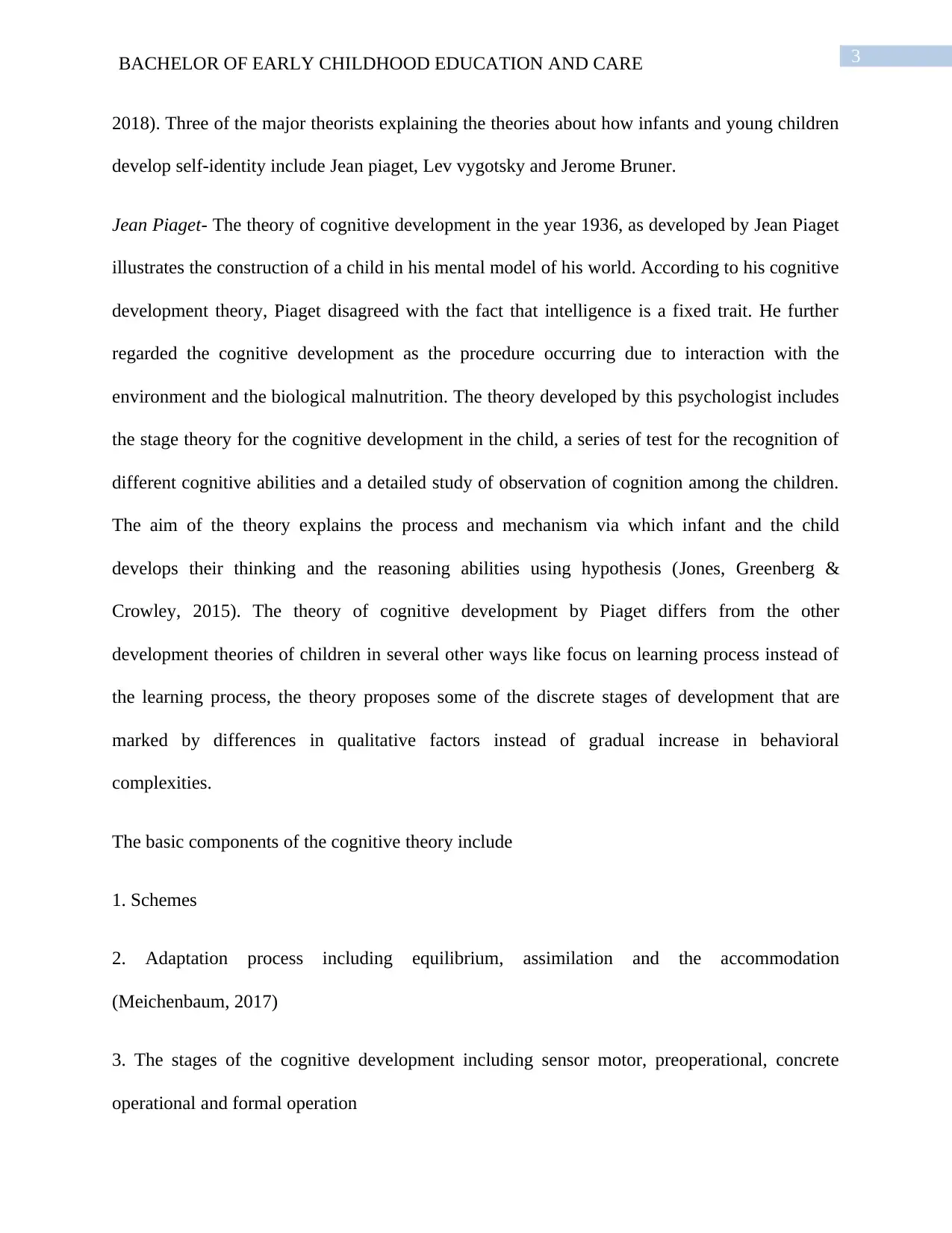
3BACHELOR OF EARLY CHILDHOOD EDUCATION AND CARE
2018). Three of the major theorists explaining the theories about how infants and young children
develop self-identity include Jean piaget, Lev vygotsky and Jerome Bruner.
Jean Piaget- The theory of cognitive development in the year 1936, as developed by Jean Piaget
illustrates the construction of a child in his mental model of his world. According to his cognitive
development theory, Piaget disagreed with the fact that intelligence is a fixed trait. He further
regarded the cognitive development as the procedure occurring due to interaction with the
environment and the biological malnutrition. The theory developed by this psychologist includes
the stage theory for the cognitive development in the child, a series of test for the recognition of
different cognitive abilities and a detailed study of observation of cognition among the children.
The aim of the theory explains the process and mechanism via which infant and the child
develops their thinking and the reasoning abilities using hypothesis (Jones, Greenberg &
Crowley, 2015). The theory of cognitive development by Piaget differs from the other
development theories of children in several other ways like focus on learning process instead of
the learning process, the theory proposes some of the discrete stages of development that are
marked by differences in qualitative factors instead of gradual increase in behavioral
complexities.
The basic components of the cognitive theory include
1. Schemes
2. Adaptation process including equilibrium, assimilation and the accommodation
(Meichenbaum, 2017)
3. The stages of the cognitive development including sensor motor, preoperational, concrete
operational and formal operation
2018). Three of the major theorists explaining the theories about how infants and young children
develop self-identity include Jean piaget, Lev vygotsky and Jerome Bruner.
Jean Piaget- The theory of cognitive development in the year 1936, as developed by Jean Piaget
illustrates the construction of a child in his mental model of his world. According to his cognitive
development theory, Piaget disagreed with the fact that intelligence is a fixed trait. He further
regarded the cognitive development as the procedure occurring due to interaction with the
environment and the biological malnutrition. The theory developed by this psychologist includes
the stage theory for the cognitive development in the child, a series of test for the recognition of
different cognitive abilities and a detailed study of observation of cognition among the children.
The aim of the theory explains the process and mechanism via which infant and the child
develops their thinking and the reasoning abilities using hypothesis (Jones, Greenberg &
Crowley, 2015). The theory of cognitive development by Piaget differs from the other
development theories of children in several other ways like focus on learning process instead of
the learning process, the theory proposes some of the discrete stages of development that are
marked by differences in qualitative factors instead of gradual increase in behavioral
complexities.
The basic components of the cognitive theory include
1. Schemes
2. Adaptation process including equilibrium, assimilation and the accommodation
(Meichenbaum, 2017)
3. The stages of the cognitive development including sensor motor, preoperational, concrete
operational and formal operation
Secure Best Marks with AI Grader
Need help grading? Try our AI Grader for instant feedback on your assignments.
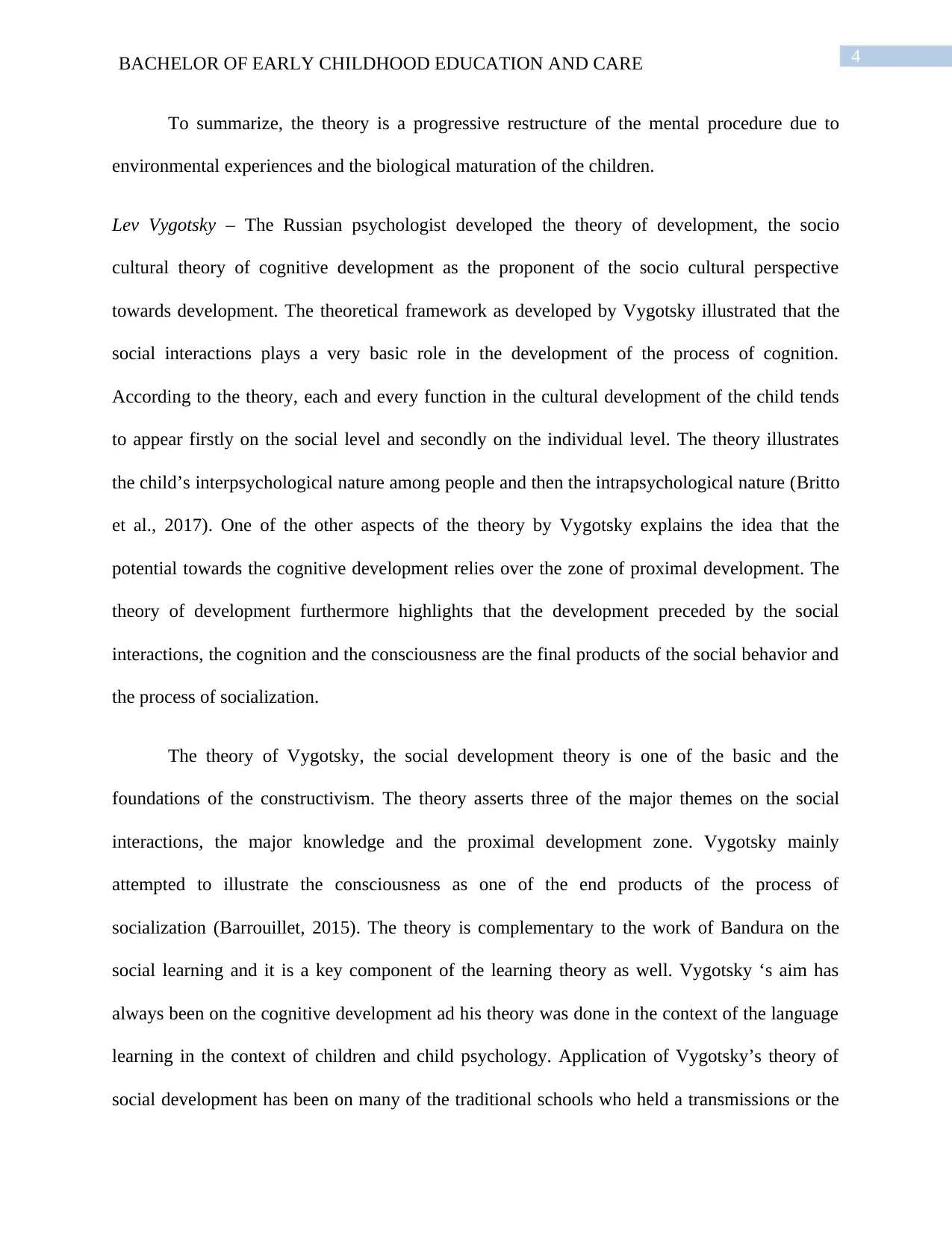
4BACHELOR OF EARLY CHILDHOOD EDUCATION AND CARE
To summarize, the theory is a progressive restructure of the mental procedure due to
environmental experiences and the biological maturation of the children.
Lev Vygotsky – The Russian psychologist developed the theory of development, the socio
cultural theory of cognitive development as the proponent of the socio cultural perspective
towards development. The theoretical framework as developed by Vygotsky illustrated that the
social interactions plays a very basic role in the development of the process of cognition.
According to the theory, each and every function in the cultural development of the child tends
to appear firstly on the social level and secondly on the individual level. The theory illustrates
the child’s interpsychological nature among people and then the intrapsychological nature (Britto
et al., 2017). One of the other aspects of the theory by Vygotsky explains the idea that the
potential towards the cognitive development relies over the zone of proximal development. The
theory of development furthermore highlights that the development preceded by the social
interactions, the cognition and the consciousness are the final products of the social behavior and
the process of socialization.
The theory of Vygotsky, the social development theory is one of the basic and the
foundations of the constructivism. The theory asserts three of the major themes on the social
interactions, the major knowledge and the proximal development zone. Vygotsky mainly
attempted to illustrate the consciousness as one of the end products of the process of
socialization (Barrouillet, 2015). The theory is complementary to the work of Bandura on the
social learning and it is a key component of the learning theory as well. Vygotsky ‘s aim has
always been on the cognitive development ad his theory was done in the context of the language
learning in the context of children and child psychology. Application of Vygotsky’s theory of
social development has been on many of the traditional schools who held a transmissions or the
To summarize, the theory is a progressive restructure of the mental procedure due to
environmental experiences and the biological maturation of the children.
Lev Vygotsky – The Russian psychologist developed the theory of development, the socio
cultural theory of cognitive development as the proponent of the socio cultural perspective
towards development. The theoretical framework as developed by Vygotsky illustrated that the
social interactions plays a very basic role in the development of the process of cognition.
According to the theory, each and every function in the cultural development of the child tends
to appear firstly on the social level and secondly on the individual level. The theory illustrates
the child’s interpsychological nature among people and then the intrapsychological nature (Britto
et al., 2017). One of the other aspects of the theory by Vygotsky explains the idea that the
potential towards the cognitive development relies over the zone of proximal development. The
theory of development furthermore highlights that the development preceded by the social
interactions, the cognition and the consciousness are the final products of the social behavior and
the process of socialization.
The theory of Vygotsky, the social development theory is one of the basic and the
foundations of the constructivism. The theory asserts three of the major themes on the social
interactions, the major knowledge and the proximal development zone. Vygotsky mainly
attempted to illustrate the consciousness as one of the end products of the process of
socialization (Barrouillet, 2015). The theory is complementary to the work of Bandura on the
social learning and it is a key component of the learning theory as well. Vygotsky ‘s aim has
always been on the cognitive development ad his theory was done in the context of the language
learning in the context of children and child psychology. Application of Vygotsky’s theory of
social development has been on many of the traditional schools who held a transmissions or the
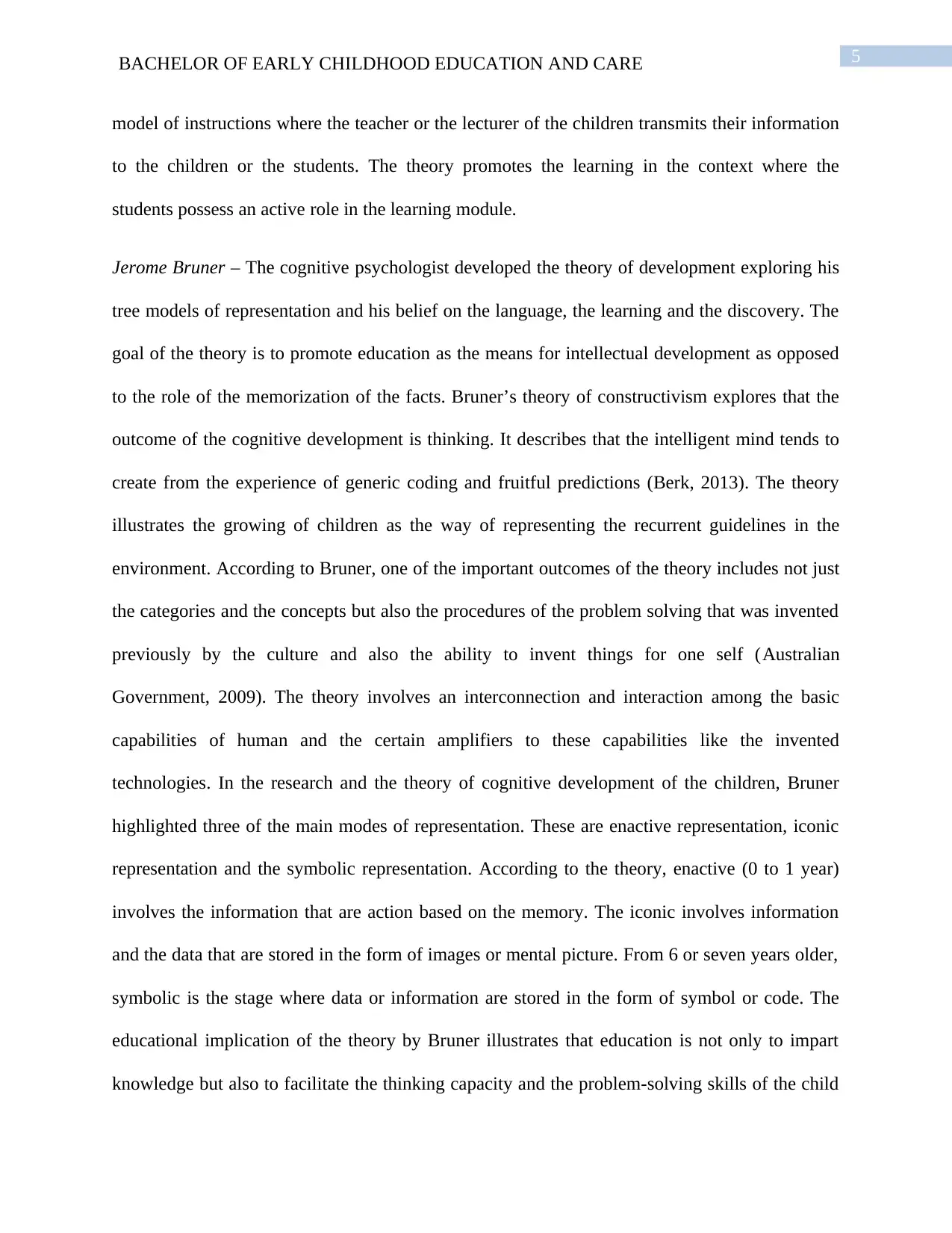
5BACHELOR OF EARLY CHILDHOOD EDUCATION AND CARE
model of instructions where the teacher or the lecturer of the children transmits their information
to the children or the students. The theory promotes the learning in the context where the
students possess an active role in the learning module.
Jerome Bruner – The cognitive psychologist developed the theory of development exploring his
tree models of representation and his belief on the language, the learning and the discovery. The
goal of the theory is to promote education as the means for intellectual development as opposed
to the role of the memorization of the facts. Bruner’s theory of constructivism explores that the
outcome of the cognitive development is thinking. It describes that the intelligent mind tends to
create from the experience of generic coding and fruitful predictions (Berk, 2013). The theory
illustrates the growing of children as the way of representing the recurrent guidelines in the
environment. According to Bruner, one of the important outcomes of the theory includes not just
the categories and the concepts but also the procedures of the problem solving that was invented
previously by the culture and also the ability to invent things for one self (Australian
Government, 2009). The theory involves an interconnection and interaction among the basic
capabilities of human and the certain amplifiers to these capabilities like the invented
technologies. In the research and the theory of cognitive development of the children, Bruner
highlighted three of the main modes of representation. These are enactive representation, iconic
representation and the symbolic representation. According to the theory, enactive (0 to 1 year)
involves the information that are action based on the memory. The iconic involves information
and the data that are stored in the form of images or mental picture. From 6 or seven years older,
symbolic is the stage where data or information are stored in the form of symbol or code. The
educational implication of the theory by Bruner illustrates that education is not only to impart
knowledge but also to facilitate the thinking capacity and the problem-solving skills of the child
model of instructions where the teacher or the lecturer of the children transmits their information
to the children or the students. The theory promotes the learning in the context where the
students possess an active role in the learning module.
Jerome Bruner – The cognitive psychologist developed the theory of development exploring his
tree models of representation and his belief on the language, the learning and the discovery. The
goal of the theory is to promote education as the means for intellectual development as opposed
to the role of the memorization of the facts. Bruner’s theory of constructivism explores that the
outcome of the cognitive development is thinking. It describes that the intelligent mind tends to
create from the experience of generic coding and fruitful predictions (Berk, 2013). The theory
illustrates the growing of children as the way of representing the recurrent guidelines in the
environment. According to Bruner, one of the important outcomes of the theory includes not just
the categories and the concepts but also the procedures of the problem solving that was invented
previously by the culture and also the ability to invent things for one self (Australian
Government, 2009). The theory involves an interconnection and interaction among the basic
capabilities of human and the certain amplifiers to these capabilities like the invented
technologies. In the research and the theory of cognitive development of the children, Bruner
highlighted three of the main modes of representation. These are enactive representation, iconic
representation and the symbolic representation. According to the theory, enactive (0 to 1 year)
involves the information that are action based on the memory. The iconic involves information
and the data that are stored in the form of images or mental picture. From 6 or seven years older,
symbolic is the stage where data or information are stored in the form of symbol or code. The
educational implication of the theory by Bruner illustrates that education is not only to impart
knowledge but also to facilitate the thinking capacity and the problem-solving skills of the child
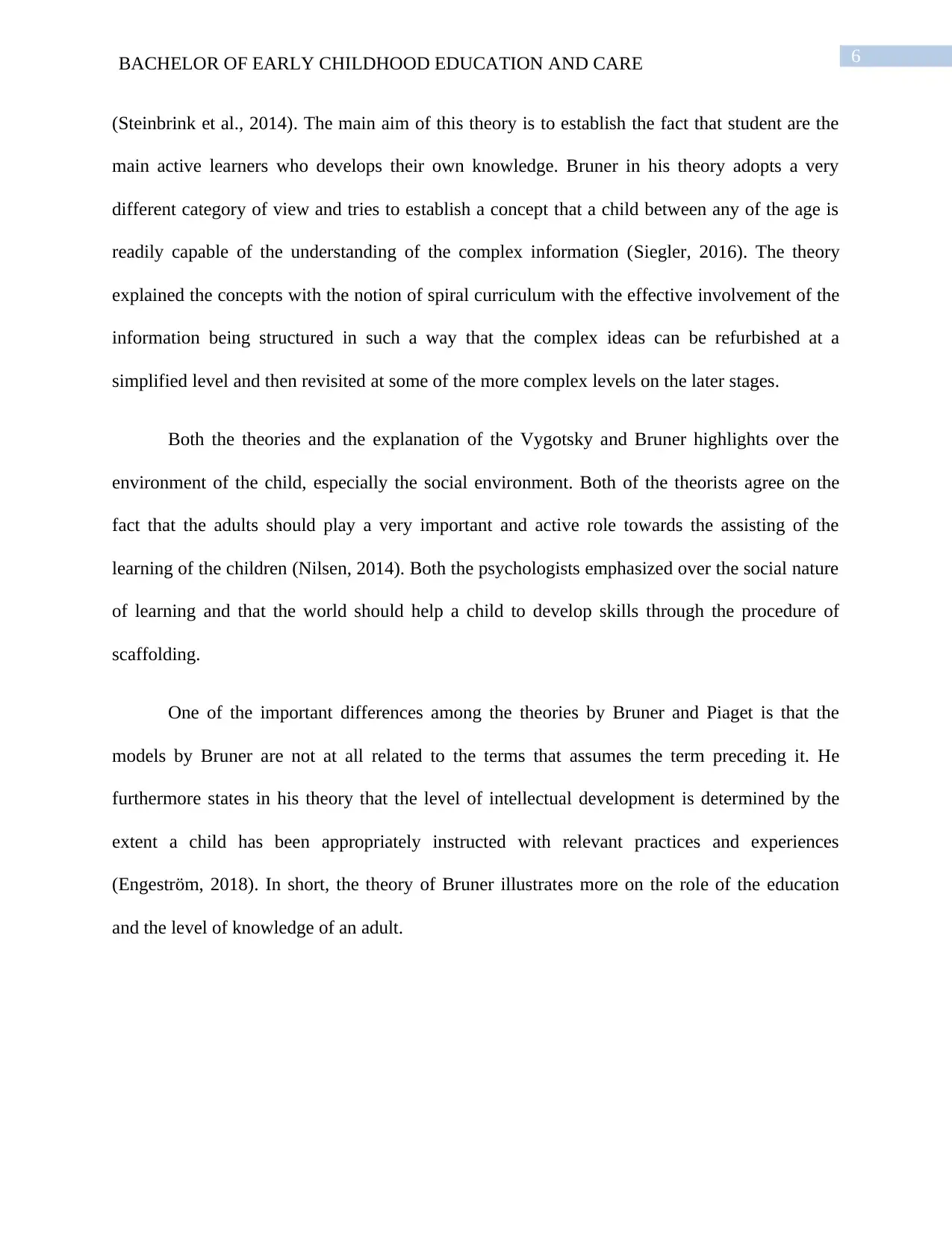
6BACHELOR OF EARLY CHILDHOOD EDUCATION AND CARE
(Steinbrink et al., 2014). The main aim of this theory is to establish the fact that student are the
main active learners who develops their own knowledge. Bruner in his theory adopts a very
different category of view and tries to establish a concept that a child between any of the age is
readily capable of the understanding of the complex information (Siegler, 2016). The theory
explained the concepts with the notion of spiral curriculum with the effective involvement of the
information being structured in such a way that the complex ideas can be refurbished at a
simplified level and then revisited at some of the more complex levels on the later stages.
Both the theories and the explanation of the Vygotsky and Bruner highlights over the
environment of the child, especially the social environment. Both of the theorists agree on the
fact that the adults should play a very important and active role towards the assisting of the
learning of the children (Nilsen, 2014). Both the psychologists emphasized over the social nature
of learning and that the world should help a child to develop skills through the procedure of
scaffolding.
One of the important differences among the theories by Bruner and Piaget is that the
models by Bruner are not at all related to the terms that assumes the term preceding it. He
furthermore states in his theory that the level of intellectual development is determined by the
extent a child has been appropriately instructed with relevant practices and experiences
(Engeström, 2018). In short, the theory of Bruner illustrates more on the role of the education
and the level of knowledge of an adult.
(Steinbrink et al., 2014). The main aim of this theory is to establish the fact that student are the
main active learners who develops their own knowledge. Bruner in his theory adopts a very
different category of view and tries to establish a concept that a child between any of the age is
readily capable of the understanding of the complex information (Siegler, 2016). The theory
explained the concepts with the notion of spiral curriculum with the effective involvement of the
information being structured in such a way that the complex ideas can be refurbished at a
simplified level and then revisited at some of the more complex levels on the later stages.
Both the theories and the explanation of the Vygotsky and Bruner highlights over the
environment of the child, especially the social environment. Both of the theorists agree on the
fact that the adults should play a very important and active role towards the assisting of the
learning of the children (Nilsen, 2014). Both the psychologists emphasized over the social nature
of learning and that the world should help a child to develop skills through the procedure of
scaffolding.
One of the important differences among the theories by Bruner and Piaget is that the
models by Bruner are not at all related to the terms that assumes the term preceding it. He
furthermore states in his theory that the level of intellectual development is determined by the
extent a child has been appropriately instructed with relevant practices and experiences
(Engeström, 2018). In short, the theory of Bruner illustrates more on the role of the education
and the level of knowledge of an adult.
Paraphrase This Document
Need a fresh take? Get an instant paraphrase of this document with our AI Paraphraser
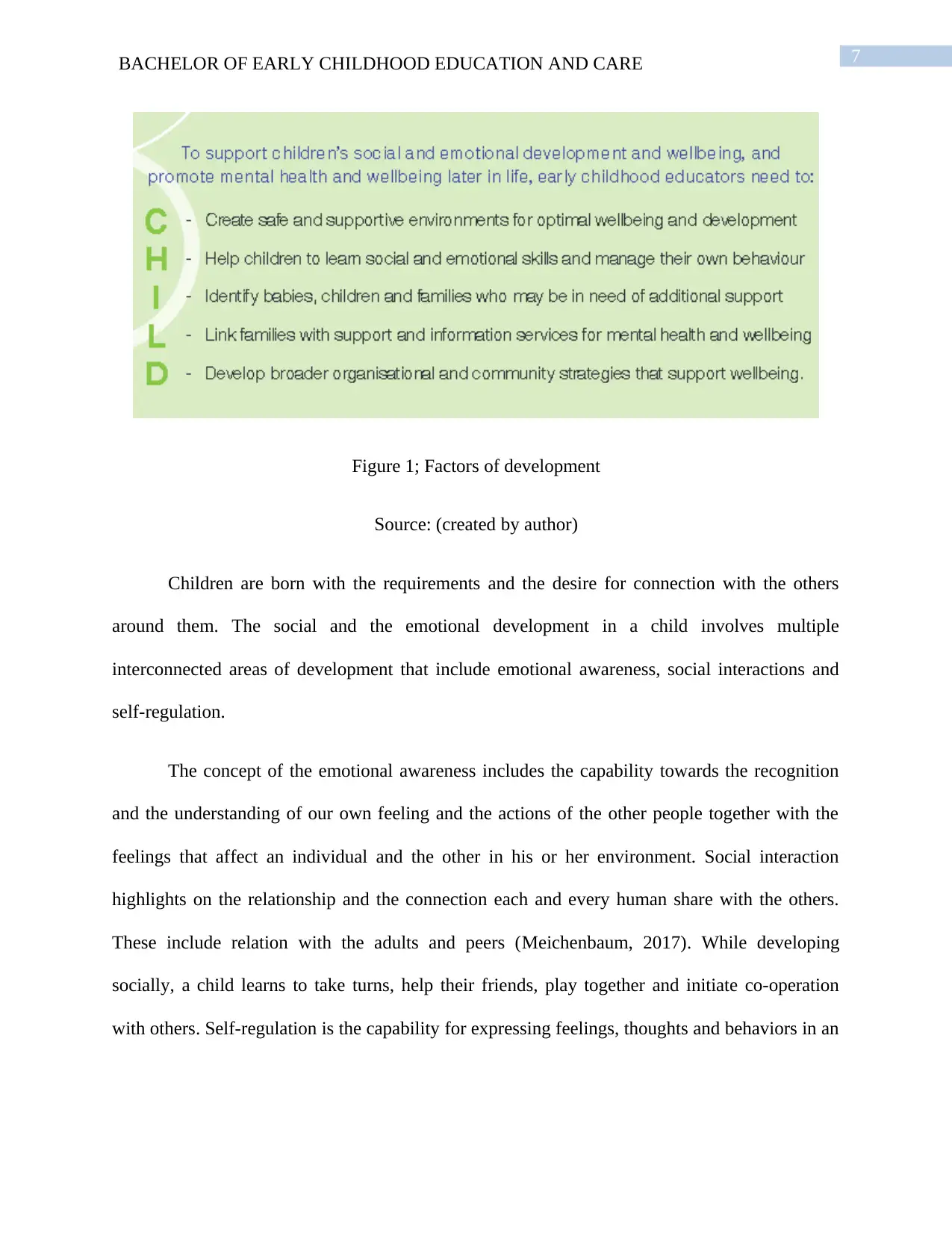
7BACHELOR OF EARLY CHILDHOOD EDUCATION AND CARE
Figure 1; Factors of development
Source: (created by author)
Children are born with the requirements and the desire for connection with the others
around them. The social and the emotional development in a child involves multiple
interconnected areas of development that include emotional awareness, social interactions and
self-regulation.
The concept of the emotional awareness includes the capability towards the recognition
and the understanding of our own feeling and the actions of the other people together with the
feelings that affect an individual and the other in his or her environment. Social interaction
highlights on the relationship and the connection each and every human share with the others.
These include relation with the adults and peers (Meichenbaum, 2017). While developing
socially, a child learns to take turns, help their friends, play together and initiate co-operation
with others. Self-regulation is the capability for expressing feelings, thoughts and behaviors in an
Figure 1; Factors of development
Source: (created by author)
Children are born with the requirements and the desire for connection with the others
around them. The social and the emotional development in a child involves multiple
interconnected areas of development that include emotional awareness, social interactions and
self-regulation.
The concept of the emotional awareness includes the capability towards the recognition
and the understanding of our own feeling and the actions of the other people together with the
feelings that affect an individual and the other in his or her environment. Social interaction
highlights on the relationship and the connection each and every human share with the others.
These include relation with the adults and peers (Meichenbaum, 2017). While developing
socially, a child learns to take turns, help their friends, play together and initiate co-operation
with others. Self-regulation is the capability for expressing feelings, thoughts and behaviors in an
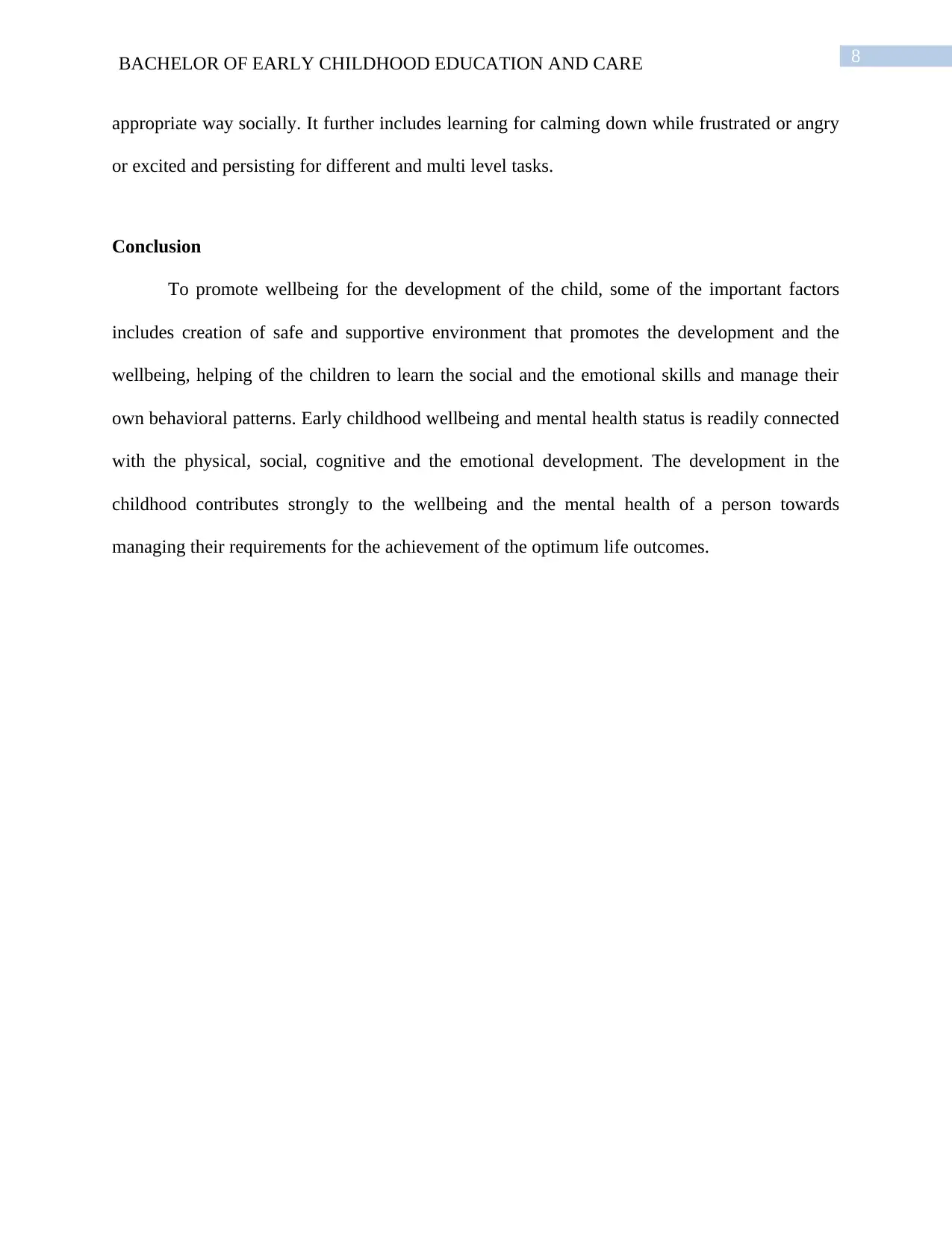
8BACHELOR OF EARLY CHILDHOOD EDUCATION AND CARE
appropriate way socially. It further includes learning for calming down while frustrated or angry
or excited and persisting for different and multi level tasks.
Conclusion
To promote wellbeing for the development of the child, some of the important factors
includes creation of safe and supportive environment that promotes the development and the
wellbeing, helping of the children to learn the social and the emotional skills and manage their
own behavioral patterns. Early childhood wellbeing and mental health status is readily connected
with the physical, social, cognitive and the emotional development. The development in the
childhood contributes strongly to the wellbeing and the mental health of a person towards
managing their requirements for the achievement of the optimum life outcomes.
appropriate way socially. It further includes learning for calming down while frustrated or angry
or excited and persisting for different and multi level tasks.
Conclusion
To promote wellbeing for the development of the child, some of the important factors
includes creation of safe and supportive environment that promotes the development and the
wellbeing, helping of the children to learn the social and the emotional skills and manage their
own behavioral patterns. Early childhood wellbeing and mental health status is readily connected
with the physical, social, cognitive and the emotional development. The development in the
childhood contributes strongly to the wellbeing and the mental health of a person towards
managing their requirements for the achievement of the optimum life outcomes.
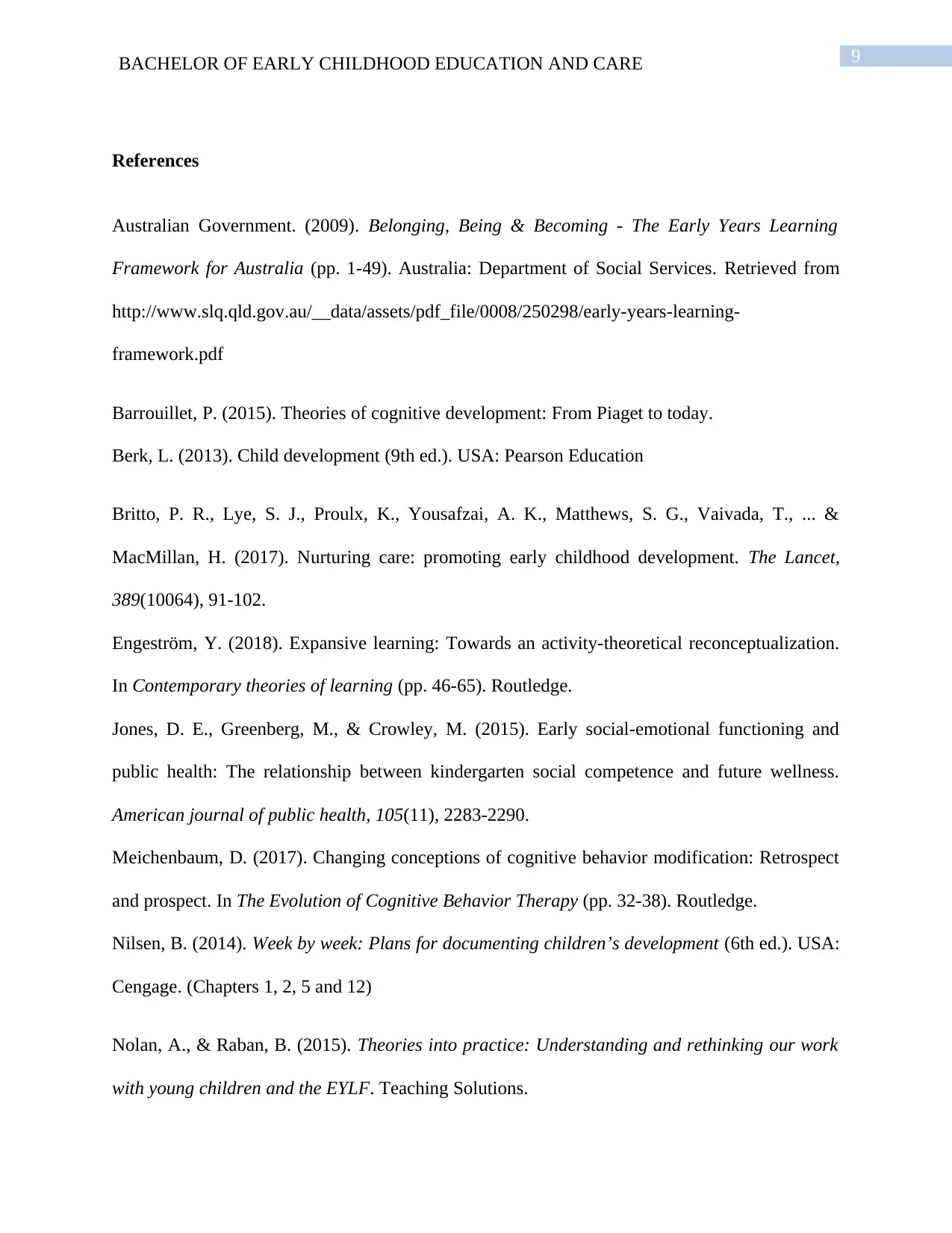
9BACHELOR OF EARLY CHILDHOOD EDUCATION AND CARE
References
Australian Government. (2009). Belonging, Being & Becoming - The Early Years Learning
Framework for Australia (pp. 1-49). Australia: Department of Social Services. Retrieved from
http://www.slq.qld.gov.au/__data/assets/pdf_file/0008/250298/early-years-learning-
framework.pdf
Barrouillet, P. (2015). Theories of cognitive development: From Piaget to today.
Berk, L. (2013). Child development (9th ed.). USA: Pearson Education
Britto, P. R., Lye, S. J., Proulx, K., Yousafzai, A. K., Matthews, S. G., Vaivada, T., ... &
MacMillan, H. (2017). Nurturing care: promoting early childhood development. The Lancet,
389(10064), 91-102.
Engeström, Y. (2018). Expansive learning: Towards an activity-theoretical reconceptualization.
In Contemporary theories of learning (pp. 46-65). Routledge.
Jones, D. E., Greenberg, M., & Crowley, M. (2015). Early social-emotional functioning and
public health: The relationship between kindergarten social competence and future wellness.
American journal of public health, 105(11), 2283-2290.
Meichenbaum, D. (2017). Changing conceptions of cognitive behavior modification: Retrospect
and prospect. In The Evolution of Cognitive Behavior Therapy (pp. 32-38). Routledge.
Nilsen, B. (2014). Week by week: Plans for documenting children’s development (6th ed.). USA:
Cengage. (Chapters 1, 2, 5 and 12)
Nolan, A., & Raban, B. (2015). Theories into practice: Understanding and rethinking our work
with young children and the EYLF. Teaching Solutions.
References
Australian Government. (2009). Belonging, Being & Becoming - The Early Years Learning
Framework for Australia (pp. 1-49). Australia: Department of Social Services. Retrieved from
http://www.slq.qld.gov.au/__data/assets/pdf_file/0008/250298/early-years-learning-
framework.pdf
Barrouillet, P. (2015). Theories of cognitive development: From Piaget to today.
Berk, L. (2013). Child development (9th ed.). USA: Pearson Education
Britto, P. R., Lye, S. J., Proulx, K., Yousafzai, A. K., Matthews, S. G., Vaivada, T., ... &
MacMillan, H. (2017). Nurturing care: promoting early childhood development. The Lancet,
389(10064), 91-102.
Engeström, Y. (2018). Expansive learning: Towards an activity-theoretical reconceptualization.
In Contemporary theories of learning (pp. 46-65). Routledge.
Jones, D. E., Greenberg, M., & Crowley, M. (2015). Early social-emotional functioning and
public health: The relationship between kindergarten social competence and future wellness.
American journal of public health, 105(11), 2283-2290.
Meichenbaum, D. (2017). Changing conceptions of cognitive behavior modification: Retrospect
and prospect. In The Evolution of Cognitive Behavior Therapy (pp. 32-38). Routledge.
Nilsen, B. (2014). Week by week: Plans for documenting children’s development (6th ed.). USA:
Cengage. (Chapters 1, 2, 5 and 12)
Nolan, A., & Raban, B. (2015). Theories into practice: Understanding and rethinking our work
with young children and the EYLF. Teaching Solutions.
Secure Best Marks with AI Grader
Need help grading? Try our AI Grader for instant feedback on your assignments.
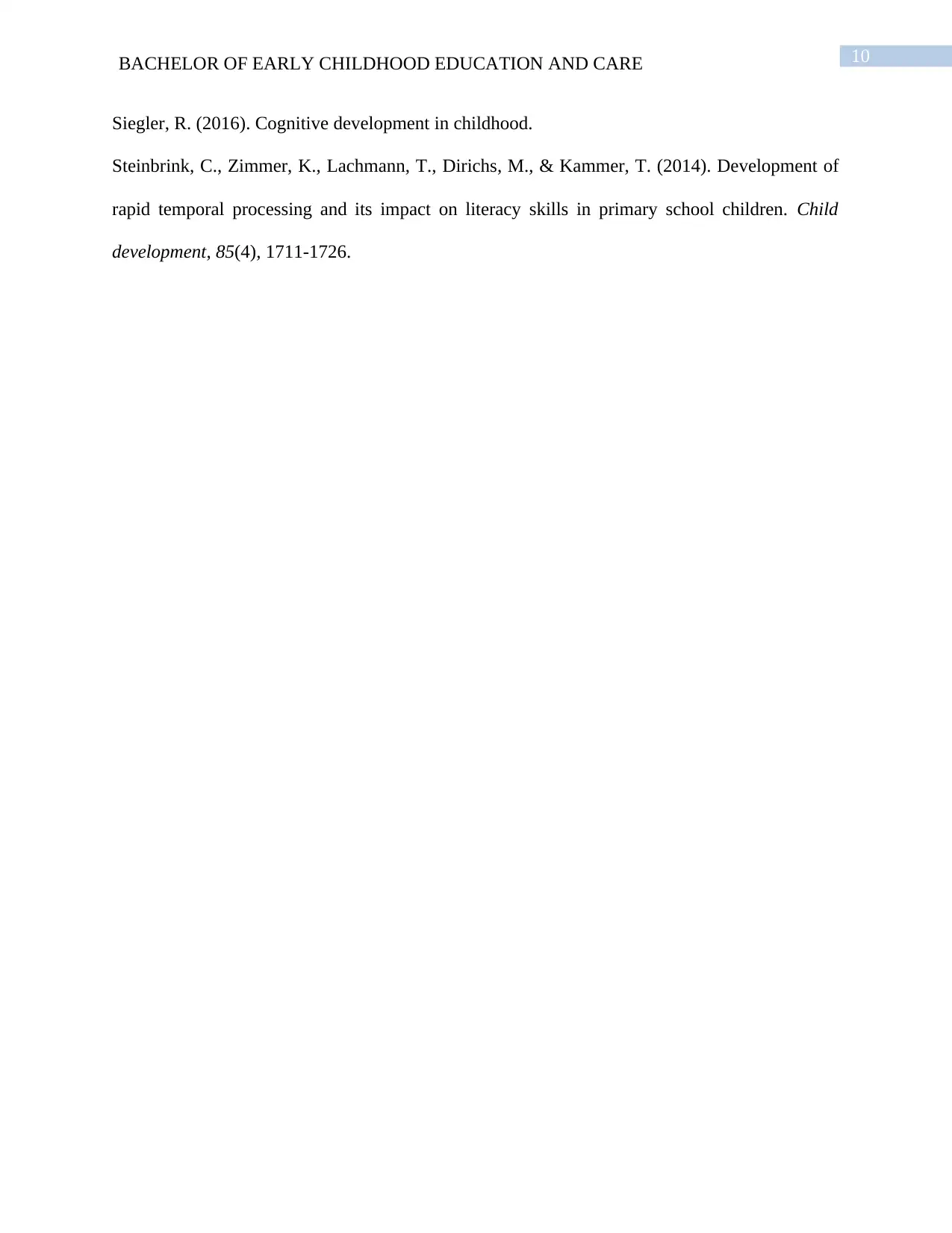
10BACHELOR OF EARLY CHILDHOOD EDUCATION AND CARE
Siegler, R. (2016). Cognitive development in childhood.
Steinbrink, C., Zimmer, K., Lachmann, T., Dirichs, M., & Kammer, T. (2014). Development of
rapid temporal processing and its impact on literacy skills in primary school children. Child
development, 85(4), 1711-1726.
Siegler, R. (2016). Cognitive development in childhood.
Steinbrink, C., Zimmer, K., Lachmann, T., Dirichs, M., & Kammer, T. (2014). Development of
rapid temporal processing and its impact on literacy skills in primary school children. Child
development, 85(4), 1711-1726.
1 out of 11
Related Documents
Your All-in-One AI-Powered Toolkit for Academic Success.
+13062052269
info@desklib.com
Available 24*7 on WhatsApp / Email
![[object Object]](/_next/static/media/star-bottom.7253800d.svg)
Unlock your academic potential
© 2024 | Zucol Services PVT LTD | All rights reserved.




